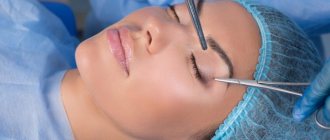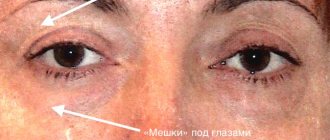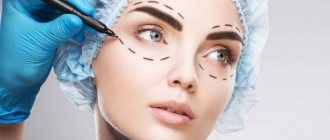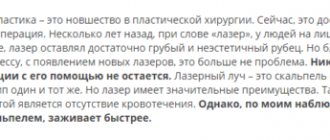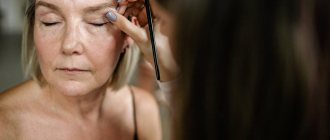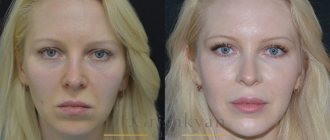- home
- Lipofilling
- Lipofilling of the upper and lower eyelids in Moscow
Lipofilling of the upper and lower eyelids can be widely used as an independent operation. Lipofilling of the eyelids will correct
- A-shaped deformation of the upper eyelids
- failed blepharoplasty
- tear trough
- bruises under the eyes
- lower eyelid hernia
With age, the layer of adipose tissue in the eyelid area becomes noticeably thinner, and the fat itself migrates and becomes deformed. Achieving the desired result in the shortest possible time, with a minimum rehabilitation period and with low risks and complications is the task that the patient sets for us. This may be why lipofilling of the face and, in particular, the eyelids is becoming increasingly popular. After all, lipofilling can meet all these requirements.
View all photos before and after eyelid lipofilling
Why do we need lipofilling?
Adipose tissue contains active “building material” that promotes growth and development. Lipofilling allows you to launch rejuvenation processes at the cellular level, characteristic of the body of a young person. Thanks to this simple and safe procedure, you can solve many aesthetic problems:
- increase the size of the mammary glands,
- give roundness to sunken cheeks,
- make thin lips look voluminous,
- adjust the depth of nasolabial folds and tear grooves,
- eliminate deep wrinkles on the forehead and bridge of the nose, acne scars. This method also successfully copes with the lack of fatty tissue in the lower and middle parts of the face, eliminating sagging skin, providing a noticeable tightening and correction of the oval. The main advantage of lipofilling is the introduction under the skin not of foreign fillers, which are often rejected by the body, but of a person’s own fat cells.
The patient underwent lipofilling of the nasolacrimal groove and nasolabial area, as well as a nanofat procedure.
Lipofilling of the lower eyelids
As for lipofilling of the lower eyelids, it is relevant both for pronounced tear troughs and in the presence of fatty protrusions (hernias). Pronounced tear trough is an extremely common problem. Moreover, it is observed not only in middle-aged patients who require full-fledged blepharoplasty, but also at a fairly young age.
The main reasons for the formation of unaesthetic depressions in the lower eyelids:
- With an anatomical tendency to a pronounced tear trough or features of the anatomical structure of the face with a lack of adipose tissue in the lower eyelids
- Consequences of traditional lower eyelid blepharoplasty with radical removal of fatty hernias
- Sudden weight loss, causing the development of skeletonization of this area of the face
What problems in the lower eyelid area can lipofilling help with?
Tear trough
Modern aesthetic surgery allows you to correct the tear trough, but when determining correction methods, a clear diagnosis of the causes of its formation is necessary. The most common reason is lack of volume. Consequently, lipofilling of the lower eyelids gives excellent aesthetic results in this case. Fat allows you not only to even out the area under the eyes, but also has a significant rejuvenating effect on the delicate skin of the eyelids. If the patient has excess skin, then lower eyelid plastic surgery is also indicated simultaneously with lipofilling.
In this case, lipofilling of the tear trough with correction of the zygomatic region was performed on a very young patient, 24 years old. The result continues to this day, for more than 8 years. Including after childbirth and breastfeeding.
Bags under the eyes
Another problem for patients seeking lower eyelid surgery is bags under the eyes. Often these patients do not realize that the problem exists at the tear trough level. The logic behind standard blepharoplasty is the decision to remove hernias in the lower eyelids down to the level of the tear trough. As a result, the patient receives either dark circles under the eyes, or, worse, drooping of the lower eyelids and an unaesthetic depression under the eyes.
In our opinion, the approach should be exactly the opposite. Adding volume during lipofilling of the lower eyelid to the area under the eyes allows not only to camouflage hernias. By equalizing differences in the levels of the hernia and the tear trough cavity, it is possible to achieve even, beautiful volumetric rejuvenation of the lower eyelid and skin. After all, the fat that we use for lipofilling contains a large number of growth factors that contribute to the rejuvenation of the eyelid skin.
Dark circles under the eyes
Another problem that lipofilling of the lower eyelids can cope with is dark circles under the eyes. A common cause of darkening of the skin around the eyes is the presence of closely spaced blood vessels and at the same time thin skin of the lower eyelids. In addition, dark circles are often the result of a pronounced tear trough, or skeletonization of the lower eyelid as a whole. In this case, lipofilling of the lower eyelid becomes the only option for solving the problem.
Benefits of lipofilling
- Fat is not a hydrophilic filler (does not attract water), which means there will be no swelling in the correction area.
- You can correct areas with a required filler volume of more than 3 ml.
- Permanently takes root in tissues, and fillers based on hyaluronic acid have a validity period of 6 – 18 months
- Natural filler, your own
As a result, lipofilling surgery with lifelong results is much cheaper than introducing the same volume of gel on a temporary basis.
In what cases is lipofilling prescribed?
This procedure is designed to eliminate a number of emerging problems:
- age-related changes in individual features and facial contour;
- significant loss of volume in certain areas;
- sagging skin, pronounced jowls, deep folds near the nose;
- atrophic scars;
- noticeable asymmetry of any origin.
Fat grafting is successfully used as an alternative to operations involving the installation of facial implants. The technique is designed to significantly rejuvenate the face, effectively increase skin tone, elasticity and firmness.
Lipofilling technique
In modern aesthetic medicine, lipofilling is represented by a wide variety of methods and techniques, which are regularly updated and improved. There are no reference standards for carrying out the procedure; each specialist, based on his own experience, chooses the method that, in his opinion, provides the best result. Good adaptation of transplanted fat cells to a new location is influenced by the use of disposable cannulas, the method of processing and injecting fat that has proven itself in practice, and the enrichment of the material with PRP mass. If we talk about the aesthetic possibilities for correcting and modeling problem areas of the patient’s body, they are truly limitless.
Lipofilling is safe
Lipofilling is a minimally invasive surgical procedure. When transplanting, natural native material is used as a filler - the patient’s own fat. This is an autograft that does not cause rejection, complications or allergic reactions.
The essence of the procedure
A general medical examination is a must before lipofilling. The surgeon also makes recommendations on the rehabilitation period after the operation.
After the operation, the patient rests for several hours. The result of this intervention will be lifelong, and the time of lipofilling is only about 1 hour. An additional advantage of this type of intervention is the absence of the need for a long hospital stay - you can return home after a few hours after the operation.
Swelling and small bruises in the intervention area disappear within a few days, leaving behind a feeling of youth and beauty for a long time.
The advent of high technologies is also associated with the introduction of the latest medical equipment and devices using laser and radiofrequency effects , which are currently widely used in many areas of plastic and aesthetic surgery. Radiofrequency and laser exposure promote the fastest healing of wounds with minimal and almost imperceptible scars, since in the least traumatic manner . Due to their versatility and multifunctionality, these devices are used in a variety of plastic surgeries. Laser technology has found its greatest application in lipomodeling procedures (including thighs), since as a result it is necessary to achieve not only the removal of excess fat, but also to achieve an even and smooth surface of the figure. Among the advantages of performing operations using radiofrequency and laser liposuction (chin, thighs, buttocks and other areas of the body), less pain and a shorter postoperative rehabilitation period can be identified.
Lipofilling consists of 4 main stages, these are:
- Infiltration of the area of fat collection in order to reduce the density and moisturize the adipose tissue. And at the same stage, anesthesia of the donor area is performed.
- Fat harvesting (we manage to obtain an autograft of the minimum size, which has the greatest chance of complete engraftment)
- Fat preparation - purification and isolation of the most viable fat cells.
- Introduction of fat autograft (multi-level injection of fat, high survival rate due to a greater number of blood vessels located in different layers of tissue than in one. The combined distribution of fat - on different layers, allows you to fill deep voids and not create excessive surface volume).
Each stage must be carried out clearly in accordance with the rules that were formulated during long-term experience in conducting operations.
In what cases is the procedure contraindicated?
The lipofilling operation has virtually no contraindications. An exception may be serious pathologies, which include:
- low blood clotting rate;
- chronic diseases of internal organs;
- established diabetes mellitus and existing other endocrine disorders;
- existing malignant neoplasms of any location;
- history of heart and vascular disease;
- identified infectious diseases of various origins.
Indications for lipofilling
Being a 100% safe and highly effective technique, facial contouring using the patient’s own fat tissue allows you to maintain the achieved results for a long time. With its help, the formation of the middle and lower zones of the face, correction of the temporal region, and the zones under the lower eyelids are usually carried out. Lipofilling is an excellent way to correct facial asymmetry associated with anatomical features. First, the specialist analyzes the degree of deformation and the causes that caused it.
Facial lipofilling as a unique method of rejuvenation
Go to photo gallery
Lipofilling is often used as an independent anti-aging procedure. In this case, fatty tissue is injected into the middle and lower areas of the face. The use of fat for the correction of nasolabial folds is very effective; the technique provides a beautiful, natural, harmonious result. Filling all the voids, the specialist seems to act as a sculptor and creates an updated, noticeably rejuvenated image. The effect is achieved through volumetric modeling of the face with fat.
Lipofilling and rhinoplasty
The patient underwent re-correction rhinoplasty and facial lipofilling. The operations were carried out in two stages. The lipofilling diagram shows the areas of fat injection.
During rhinoplasty, there is often a need to adjust the shape of the chin. Many plastic surgeons use an effective and low-traumatic method for this purpose – lipofilling. Rhinoplasty is combined with lipofilling of the chin area. Some patients also require volumetric correction of the midface area and the formation of the zygomatic elevations. At the first stage, the specialist corrects the lower third of the face and chin area, and then begins work on the cheekbone area.
Volumetric correction with fat can eliminate many aesthetic defects in the periocular area, including reducing the depth of the lacrimal glands. The tear trough is filled with transplanted fatty tissue, resulting in smoother transitions from the eyelids to the cheeks and cheekbones. An excellent result is provided by a combination of correction of age-related deformities of the lower eyelids and the middle facial zone.
Lipofilling and complex correction of age-related changes
The patient underwent upper and lower blepharoplasty with skin excision and lipofilling of the entire face, with deep treatment of the middle zone. Since fat triggers internal rejuvenation of facial tissues, we were able to restore the middle zone, improve the quality of the skin and somewhat delay facial plastic surgery.
Plastic surgeons usually perform complex correction of age-related changes in the face using techniques such as SMAS-LIFT and installation of Silhouettelift support threads. Fatty tissues are designed to fill the missing volume in the middle facial zone, as well as in the area of the lips and chin, and eliminate defects and deformities of the face of various origins.
The main advantage of lipofilling is its ability to effectively complement most rejuvenation methods known in plastic surgery. The procedure for introducing fatty tissue under the skin is low-traumatic, involves a short rehabilitation period, and is carried out under both local and general anesthesia. The effect of skin rejuvenation is noticeable almost immediately and lasts for many years.
Scar lipofilling
The patient’s “native” fat is an ideal filler that is not rejected by the body and quickly takes root in a new place. Another unique property is its ability to erase scars from the surface of the skin and restore tissue damaged after removal of tumors and chemotherapy. According to recent scientific research, adipose tissue injected into the injured area stimulates its accelerated healing. With the help of fat, it is possible to quickly heal poorly healing wounds. The use of lipofilling is relevant for people with diabetes and non-healing wounds on their legs. Fat tissue successfully copes with scars of any type, including retracted ones, formed in the place of the mammary glands after their removal. Damages that appear on the surface of the skin after chemotherapy also heal. Using fat, it is possible to fill any depressions and correct unevenness in different parts of the human body.
What we guarantee:
- absence of lumps and compactions; -high degree of fat survival; - lifelong results.
Lipofilling of the upper eyelids
Loss of volume in the upper eyelid region causes drooping of the lateral edge of the eyebrow and eyelid, creating the appearance of excess skin and ptosis of the upper eyelid.
The main indication for surgery is
- Skeletonization of the upper eyelid
- Age-related skeletonization of the upper eyelid caused by atrophy or migration of adipose tissue
- Skeletonization of the eyelid associated with the anatomical features and structure of the eyes
- Skeletonization resulting from excessive fat removal during upper eyelid surgery
In this case, lipofilling made it possible to correct the skeletonization and asymmetry of the upper eyelid.
When diagnosing the patient’s face before surgery, we do a comprehensive analysis of the entire upper third of the face. By performing lipofilling of the upper eyelid, we are able to restore the volume. Sometimes we perform this procedure in combination with a lateral brow lift. This allows you to return the eyebrow to the correct anatomical position, and thereby solve the problem of excess skin of the upper eyelid, without resorting to traditional blepharoplasty.
In young patients under 40 years of age, in the absence of significant excess skin of the upper eyelid, this method gives significant aesthetic results. Lipofilling of the upper eyelid goes well with such rejuvenating operations as upper eyelid plastic surgery, forehead lifting, temple lifting, and circular facelift. In addition, it must be said that lipofilling of the upper eyelid is an extremely delicate operation. This is due to the fact that the skin of the upper eyelids is very thin, and any contouring of fat in this area will be noticeable.
The patient underwent correction of upper eyelid deformity A and lipofilling of the upper and lower eyelids.
Lipofilling of the upper eyelid is often performed together with lipofilling of the temporal zone and lipofilling of the eyebrow. Lipofilling of the uppermost eyelid is done in both the fixed and movable parts of the eyelid.
Complications of lipofilling
Lipofilling is a minimally invasive procedure that is well tolerated by most patients and has noticeable, quickly achievable results. The effect obtained after fat transfer lasts for life. This is easy to explain. Live fat cells, which are parts of the patient’s body and his native building material, are used as a filler. Fat cells live as long as their owner lives. The result of lipofilling is not affected by weight loss amounting to no more than 10% of the total body weight. Provided that the operation is carried out correctly with strict adherence to the technology of its execution and the use of disposable micro-instruments, the formation of lumps of fat and the appearance of unevenness on the surface of the skin are completely excluded.
After the operation, bruises and swelling, small hematomas may appear, which usually disappear within ten days. Infection of the wound with strict adherence to the rules of asepsis and antisepsis during the procedure and postoperative hygiene is completely excluded. Swelling varies in size, depending on the amount of material injected and the areas of injection. Sometimes there is a change in color, thickening, and decreased sensitivity of the treated areas of the skin, which disappear as the dermis recovers.
Smoking patients may experience partial resorption of the injected fat. In such situations, a repeat procedure is recommended after one to two months. Repeated lipofilling may also be required in case of significant deformations of the corrected areas, when it is impossible to introduce the required amount of filler at a time. The need for repeated injection of fat tissue is determined by the individual characteristics of the patient’s body, the degree of achievement of the desired result and is not considered as a postoperative complication.
Rehabilitation during eyelid lipofilling
Lipofilling of the eyelids, like any other lipofilling, is a low-traumatic procedure. It can be performed under local anesthesia, and the patient leaves the clinic on the day of the operation. After lipofilling of the eyelids, as a rule, there are no bruises or scars left on the face, and swelling is minor and goes away on its own within two weeks. The main injury occurs in the area of the donor zones; bruising and swelling may remain there. This is especially possible if the patient simultaneously underwent full liposuction or more extensive lipofilling than just lipofilling of the eyelids. In this case, compression garments and physiotherapeutic procedures are recommended. To prevent the survival of fat and accelerate vascularization, it is recommended to perform several procedures of placental therapy.
Rehabilitation after lipofilling
A short rehabilitation period without significant visual signs of injury to the skin is a significant advantage of lipofilling. The low morbidity is explained by the nature of the procedure. During the procedure, the specialist works with the help of micro-instruments, making only small holes on the skin through which fatty material prepared in advance in a special way is introduced. The size of the instrument (the so-called cannula) is only 1.5-1.7 mm and has a blunt shape, rounded at the end. Thanks to this, the blood vessels are not damaged and the risk of bruising is significantly reduced.
The content of a large number of growth factors in adipose tissue in itself provides powerful stimulation of the skin and rapid healing. Fibroblasts are connective tissue cells of the human body, responsible for the synthesis of the extracellular matrix. The latter is the basis of connective tissue, providing support to cells and providing them with the chemicals necessary for life. During the healing process of injured skin areas, fibroblasts rush to the site of damage, carrying out intensive synthesis of the extracellular matrix, including collagen and elastin fibers. As a result, fat stimulates the accelerated course of rehabilitation processes and starts the process of rejuvenation of tissues located in the affected areas.
The duration of the rehabilitation process is influenced by the patient’s age, his bad habits (especially smoking), and the use of medications that slow down blood circulation. With normal cell nutrition, fat takes root very quickly, only a small part of the injected material dies off. The amount of fat used in each specific case is determined individually and is strictly controlled. The final result of lipofilling can be assessed two months after it is performed, since by this time the volume of successfully engrafted adipose tissue can be determined. Typically, correction is required for areas of the chest, legs, and buttocks, since in these areas of the body the germination of blood vessels and the fixation of fat cells occurs worse than on the face. The results of the procedure in the listed areas are assessed only six months after its implementation.
Sutures are not required after lipofilling. The practice is to use strips - thin strips of flesh-colored adhesive. This allows the patient to see the preliminary results of the operation almost immediately after it is performed. The need for strips disappears the very next day. Patients do not require observation in a hospital setting. As a rule, after the procedure is completed, they are allowed to leave the clinic and continue rehabilitation at home.
Correcting one's appearance using a scalpel is a traumatic and unsafe procedure, which not every woman can decide to undertake. But to the great joy of the fair sex, aesthetic medicine can offer a unique and effective alternative to radical surgery.
Effectiveness of the procedure
Since lipofilling is the least traumatic procedure, it is often recommended to quickly restore youth to the face and give a more attractive appearance to both the face and body. Getting rid of pronounced nasolabial folds, tear troughs, eliminating defects in the lower part of the face due to insufficient fat tissue in this area - all this quickly returns youth and gives self-confidence.
And since this particular procedure is not based on the introduction of a temporary “beauty injection”, which has a pronounced effect only for a limited time, but on the use of one’s own adipose tissue, the duration of the manifestation is guaranteed to be long.
The cost of lipofilling at the Doctor Grishkyan clinic in Moscow.
Facial lipofilling
| Operation name | Cost in rubles |
| Lipofilling of the upper eyelids | 160000 |
| Lipofilling of the lower eyelids | 160000 |
| Lipofilling of the lower eyelids with transblepharoplasty | 180 000 |
| Lipofilling of the midface, including the lower eyelids | 180000 |
| Lipofilling of the face, including the lower eyelids | 250000 |
| Facial lipofilling, including upper and lower eyelids | 310 000 |
| Lipofilling of the lower third of the face | 120000 |
| Chin lipofilling | 90000 |
| Facial rejuvenation with growth factors (“Nanofat”) | 60000 |
Lipofilling of legs
| Operation name | Cost in rubles |
| Lipofilling of the legs | 150000 |
Hand lipofilling
| Operation name | Cost in rubles |
| Hand lipofilling | 120000 |
The author's method of eyelid rejuvenation by Professor D.R. Grishkyan
World expert in the field of lipofilling, professor, doctor of medical sciences David Rubenovich Grishkyan says:
... The widespread use of eyelid lipofling as a method of rejuvenating the periorbital region is hampered by the imperfection of the technology for introducing a fatty autograft. It is known that the relative, at first glance, simplicity of the technique can play a “wicked joke” on the surgeon, leading to complications. But the complication of lipofilling can only be corrected surgically. Work on the eyelid lipofilling method in order to obtain an “ideal” result is still ongoing. Such a feature as the unpredictability of the engraftment of fat autograft is not so significant today. But we pay special attention to the issue of the volume of one-time injection of fat. Why do I consider this question to be the main one in obtaining the desired result in rejuvenating the lower eyelids? Let me explain the main points:
Correction of A-deformation of the upper eyelid.
• Techniques for fat injection during eyelid lipofilling
As a rule, when carrying out lipofilling, two main techniques are used. The first is the so-called “spraying” method. With this method, a small amount of fat is injected into a specific area using dozens of small strokes.
Blepharoplasty of the upper eyelids and lipofilling of the midface, including the lower eyelids.
The second technique is the linear insertion technique. In our opinion, the first technique has a number of disadvantages. – Numerous movements of the cannula cause tissue injury. – Tissue swelling may interfere with the analysis of the results obtained. – It is difficult to control the volume of injection, especially if the surgeon does not have sufficient experience in performing the operation. – As a rule, the introduction of fat with this technique occurs when the cannula moves forward, which is fraught with complications. In his daily practice, surgeon D.R. Grishkyan uses the technique of slow retrograde linear injection of fat autograft.
In the lower eyelids, fat is added for correction even in the presence of hernias. The volume of fat in hernias is not sufficient to correct all the voids in the infraorbital region. Therefore, promises of fat redistribution to smooth the lower eyelid area do not work.
This technique allows you to carefully control the volume, layers and area of fat injection, avoiding overcorrection and vascular injury.
• Multi-layering as a principle for introducing fat
The next point is the principle of introducing fat. An important factor is layering. We do not inject fat like a regular filler, but place the graft layer by layer according to the principle of building a pyramid. In this case, it is important from which layer to start adding fat. As a rule, we begin the introduction from the deep layers and then move higher to the skin. However, in some cases it is recommended to start the introduction from the superficial layers. The main choice of layer is the thickness of the leather.
In this case, fat was injected at different depths, into different layers, to correct all the problems of the lower eyelids and midface that arose due to loss of volume.
Result after lipofilling surgery.
• Volume of administration
To correct the periorbital area, we introduce the volume of fat implant that we consider necessary. But the main thing that needs to be taken into account when mentioning the volume of injected fat is the size of the fat autograft . In our practice, we use fat implants of the smallest possible size, and it was the reduction in the size of the injected fat tissue and the combination of techniques that allowed us to increase the volume of injection, avoiding complications
